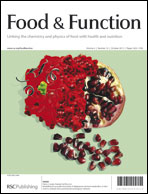Partial characterization, in vitro antioxidant and antiproliferative activities of patatin purified from potato fruit juice
Abstract
Patatin from potato fruit juice was purified by a combination of ultrafiltration and chromatographic techniques. The in vitro antioxidant and antiproliferative activity against mouse melanoma B16 cells of patatin were investigated. The results showed that the monosaccharide composition of patatin included rhamnose, mannose, glucose, and galactose with a molar ratio of 41 : 30 : 21 : 8, and patatin consisted of (1 → 3) linked α-mannose, (1 → 4) linked α-galactose, (1 → 4) linked β-glucose, and (1 → 2) linked α-rhamnose. Furthermore, patatin possessed significant antioxidant activities measured by scavenging of the DPPH and superoxide free radicals, notable reducing power, protective effects against hydroxyl radical-induced oxidative DNA damage and lipid peroxidation inhibitory. Moreover, patatin was identified as a potent antiproliferative agent against mouse melanoma B16 cells, causing cell cycle arrest in the G1 phase. Assays of apoptotic cells also showed that patatin treatment at concentrations of 20 mg mL−1 resulted in a marked reduction of viable cells. These results obtained in in vitro models suggested that patatin may have potential application as a cancer chemopreventive agent and food ingredient.


 Please wait while we load your content...
Please wait while we load your content...